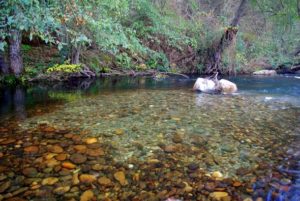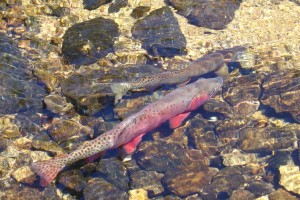Recognizing Redds Can Help Sustain Healthy Trout Populations
By: Ameen Hosain As an angler it is often easy to forget the true value of the fish one is trying to catch. In streams and rivers, trout must go through a long, and daunting process in order to sustain populations. Naturally reproducing fish endure tiring days, where males endlessly compete with each other for territory and where females work extremely hard to create and protect the right environment for eggs to be laid and fertilized.
During spawning seasons, especially in waters with naturally reproducing fish, one of the most important and often unnoticed ways that anglers have an effect on trout populations is by disturbing trout on spawning redds.
When anglers have a lack of knowledge regarding what redds look like, as well as the purpose they serve, it increases the chance of disturbing the redds and ultimately harming the stream's trout population.
 Locating trout redds can often be a difficult task, however there are a few things to look for before stepping into the water, or when observing fish. The first and most telling sign of redd is a section of bright, clean gravel in shallow water (seen right). Female fish will turn over gravel to create hospitable areas to lay their eggs. This process in itself consumes much of a fish’s energy and by stepping on or disturbing these gravel beds, a fish’s energy goes to waste.
Locating trout redds can often be a difficult task, however there are a few things to look for before stepping into the water, or when observing fish. The first and most telling sign of redd is a section of bright, clean gravel in shallow water (seen right). Female fish will turn over gravel to create hospitable areas to lay their eggs. This process in itself consumes much of a fish’s energy and by stepping on or disturbing these gravel beds, a fish’s energy goes to waste.
Another telltale sign indicating a redd is a pair of fish swimming very close together- almost always on top of a recently created gravel bed. These fish are a pair, one male and one female, with the female protecting her laid eggs, and the male attempting to fertilize them. This male can often be observed voraciously defending his position, frequently chasing off other fish who are attempting to take his hard earned place at the female’s side.
 Choosing whether or not to fish to spawning trout is an issue that sees much debate, however with conservation in mind, it is highly recommended to leave these fish alone. In the act of spawning, fish expend large amounts of energy and are exhausted. Hooking into these trout will often leave them much too tired, with mortality rates highly escalated even after a safe release.
Choosing whether or not to fish to spawning trout is an issue that sees much debate, however with conservation in mind, it is highly recommended to leave these fish alone. In the act of spawning, fish expend large amounts of energy and are exhausted. Hooking into these trout will often leave them much too tired, with mortality rates highly escalated even after a safe release.
In waters where trout rely on the spawning process to survive, harming fish can have a profound effect on populations, resulting in lowered fish counts, and less productive fisheries. Anglers fishing in wild waters should pay close attention to spawning seasons, and steer clear of fish attempting to spawn. Doing so will aid in maintaining healthy fish populations, as well as ensure that there are wild fish to catch far into the future.